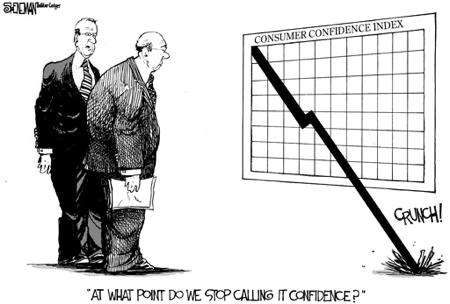Consumer Sentiment in U.S. Unexpectedly Declined in July
The recent increases in mortgage rates and prices at the gas pump may have restrained consumers’ views on the economy in the next six months. At the same time, the group’s gauge of current conditions jumped to a six-year high as stock prices approached a record after falling in the middle of June.
“It’s a slip in confidence from recent highs rather than the start of a new downward,” said Gennadiy Goldberg, a strategist at TD Securities Inc. in New York. “As we get later in the year and the economy improves, consumers will start to see better numbers and they’ll notice that.”
Forecasts of the 66 economists for sentiment in the Bloomberg survey ranged from 80 to 88. The index averaged 64.2 during the recession that ended in June 2009, and 89 in the five years prior.
The Michigan survey compares with the weekly Bloomberg Consumer Comfort Index, which climbed to minus 27.3 in the week ended July 7, the highest level in more than five years, from minus 27.5. The figures showed Americans were more upbeat about their finances than at any time since April 2008, while a gauge of the buying climate increased to a nine-week high.
Producer Prices
Other figures today showed prices paid to producers rose 0.8 percent in June, more than projected and the most since September.
The Michigan survey’s measure of current conditions, which takes stock of Americans’ views of their personal finance, increased to 99.7 in July from 93.8 at the end of last month.
The gauge of expectations six months from now fell to 73.8 from 77.8.
Mortgage rates this week climbed to the highest level in two years. The average 30-year fixed rate was 4.51 percent in the week ended yesterday, according to data from Freddie Mac. In November, it fell to a record low of 3.51 percent.
Gasoline prices have also increased this week. The average cost of a gallon of regular gas in the U.S. was $3.55 yesterday, up from $3.47 at the end of last week, according to figures from AAA, the nation’s largest motoring organization.
Job Growth
At the same time, job and income growth is helping drive consumer spending, which accounts for about 70 percent of the economy. Labor Department data last week showed employers added 195,000 workers for a second month in June. The figures also showed hourly earnings in the 12 months to June rose by the most since July 2011.
Retail sales rose 0.6 percent in May, the biggest increase in three months and propelled by a jump in motor vehicle purchases, Commerce Department figures showed last month.
Cars and light trucks sold at a 15.89 annualized rate in June, the strongest since November 2007, according to data from Ward’s Automotive Group.
General Motors Co. said June sales were up 6.5 percent from the same month last year, marking the Detroit-based company’s best sales month since September 2008.
“We’re in an economy that gets a little bit stronger each and every month,” said Kurt McNeil, vice president of U.S. sales and service, speaking during a July 2 earnings call. “The fact that the jobs data is finally trending positive, the stable fuel prices, consumer sentiment and confidence showing positive signs, we think that’s finally unlocking the American families coming in to our showrooms.”
Consumers surveyed for today’s confidence report expect an inflation rate of 3.3 percent over the next 12 months, up from the June forecast of 3 percent, today’s report showed. Over the next five years, Americans expect a 2.9 percent rate of inflation, matching the previous three months.



Leave a Reply
Want to join the discussion?Feel free to contribute!